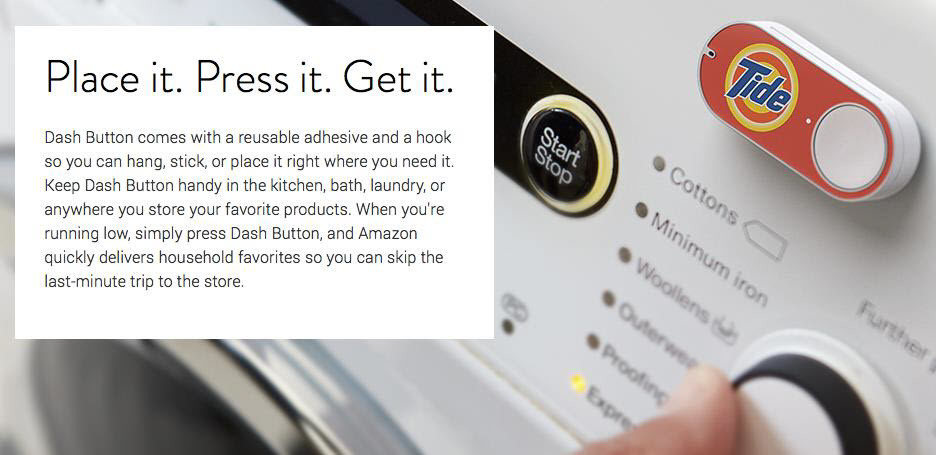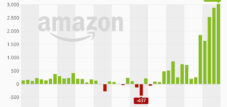What they can mean for the future of intralogistics
Whether it was ultimately an April Fool's joke or not - Amazon's announcement of a so-called Dash Button , with which consumers can order goods even more easily (of course only from Amazon), generated a lot of response in the media.
The idea behind it sounds very simple, but it is all the more effective. The button is a plastic housing about the size of a thumb with a large button that is visually reminiscent of a doorbell. The device has an adhesive strip on the back for attachment. Using a transmitter installed in the housing, the system can contact the Amazon app on the user's smartphone via its own WLAN. If you now press the button, an order for the product will be added to the Amazon shopping cart.
So that incorrect orders are not accidentally placed, the button is locked after pressing it once - as an integrated child lock. A further order is only possible after the goods have been delivered to the customer. Additionally, every purchase must first be confirmed in the app before the order is completed.
Direct networking with the customer is the goal
Amazon has already concluded a number of collaborations with household product manufacturers and has marked the button with corresponding brand logos. The user then attaches the Dash button to the places where the household goods are needed - for example in the bathroom or kitchen.
The respective Amazon buttons are still tied to predefined products. The user would therefore be forced to install a large number of not very attractive buttons in his home. However, it is foreseeable that the individual units will be assigned additional functions in the near future, such as the individual storage of additional products and services via the Amazon app.
The idea behind it is anything but new. Various manufacturers have been working on similar order buttons for years, but in contrast to Amazon's approach, they are integrated directly into the devices. Printers that ensure a constant supply of ink cartridges via an integrated order button or coffee machines that automatically order pads when supplies are running low are nothing new.
However, when an industry heavyweight like Amazon takes on the topic, it takes on a completely different dynamic and dimension; In principle, the model makes it possible to order a wide variety of durable and consumer goods.
Amazon 's goal is clear: the networking and integration of the shop giant into our everyday lives should be further advanced and Amazon should thus become an indispensable partner when purchasing everyday products - a position that is currently mostly held by supermarkets and the like location-based retail.
Solutions for companies too
And the market seems limitless, because there is also a great need in industry for automated demand reporting systems that independently register and reorder when stocks of spare parts or items are running low. A number of manufacturers offer solutions in which, for example, scales, rockers or light pulses are used to check whether a container with parts falls below a predefined weight or volume, which the software interprets as an indication of an upcoming reorder. This eliminates the need for staff to manually check the fill levels. In addition, the extremely precisely calibrated measuring devices can, under certain circumstances, also carry out the labor-intensive counting process of a warehouse inventory.
Impact on intralogistics
Ordering the desired item at the push of a button, delivery on the same day – what until recently sounded like a dream for die-hard e-commerce customers is rapidly becoming a reality.
However, in order to be able to efficiently manage the almost unmanageable flow of goods, a sophisticated intralogistics concept on the part of the provider is essential. Particularly when it comes to same-day delivery, in addition to effective software that processes incoming orders quickly, it is also important to pick and ship the goods in the warehouse immediately. Geographically, in addition to large central warehouses, there will also be a demand for buffer warehouses spread across the country so that the dress ordered at lunchtime is actually with the customer for the dinner party in the evening.
Some people are already seeing mobile units - especially when it comes to consumer goods such as washing powder or toilet paper - that are constantly on the move and immediately drive to the customer to deliver the goods when the order is received. Certainly a path that would lead to heated discussions, especially in view of the often overloaded road network.
A smoothly functioning warehouse logistics chain is all the more important. From a cost perspective, the many storage facilities scattered across the country will usually be smaller units, but in which a large variety of A and B products must be kept. Conventional rack warehouses are not the optimal solution here due to their relatively high space requirements and comparatively slow order picking. Instead, automated storage and retrieval systems such as horizontal carousels or storage paternosters could be used, which allow several hundred picks per hour and can be managed by relatively small teams. The devices, which work according to the goods-to-person principle, also ensure good ergonomics in the workplace for the staff and allow quick, safe picking at the picking points.
And this is exactly what retailers need, precise and fast order processing, in order to live up to their own shipping promises and at the same time meet the high expectations of their customers.



